
A total return index is a type of index that measures the performance of a group of securities, including dividends and capital gains, over a specific period of time.
It's a more comprehensive way to evaluate investment performance than a price return index, which only looks at changes in the stock's price.
The total return index takes into account the dividend yield of the securities in the index, which can provide a more accurate picture of the investment's overall performance.
By considering both dividends and capital gains, a total return index can give investors a more complete understanding of their investment's performance over time.
What Is Total Return Index?
The total return index (TRI) is a benchmark to determine the actual returns for the underlying assets of a mutual fund. It measures both dividend returns and capital appreciation.
It assumes that all the dividends were reinvested, which is a crucial factor in calculating the TRI.
The TRI takes into account all equities that reinvest their dividends back into the company, giving investors a more complete picture of the fund's performance.
If this caught your attention, see: Pimco Total Return Fund Class a
Understanding Total Return Index
The total return index is a benchmark that shows the actual return on an investment, including both price changes and dividends. It's a more accurate reflection of the investment's performance.
The total return index takes into account the dividends received from the investment, as well as the interest earned on those dividends. This is in contrast to the price return index, which only tracks price movements.
In fact, the total return index can make a significant difference in the return on an investment. For example, the SPDR S&P 500 ETF had a price return of 789% since its introduction in 1993, but its total return, including dividends, was close to 1,400%.
The total return index is also more transparent, as it reflects the total gain or loss on an investment. This is in contrast to the price return index, which may overstate the performance of a mutual fund and potentially mislead investors.
Here are some key differences between the total return index and the price return index:
The total return index is a valuable tool for investors, as it provides a more accurate picture of an investment's performance. By considering both price changes and dividends, the total return index gives investors a clearer understanding of their returns.
Calculating the Total Return Index
Calculating the Total Return Index involves a three-step process. The first step is to determine the dividend per index point by dividing the dividends paid by the base cap of the index.
The base cap is used to find the points of an index, giving the dividend payment value per index point. This is represented by the equation: Indexed dividend (Dt) = Dividend Paid out / Base Cap Index.
To adjust the price return index for a given day, you add the dividend and price change index, then divide by the previous price return index. This calculation can be portrayed as: (Today’s PR Index + Indexed Dividend)/Previous PR Index.
Discover more: Life Insurance Indexed Universal Life
The total return index is calculated by applying the adjustments to the price return index to the total return index, accounting for the full history of payment of dividends. This value is multiplied by the earlier day's TRI index.
The formula for calculating the total return index is: Total Return Index = Previous TR * [1+ {(Today’s PR Index + Indexed Dividend)/Previous PR Index}-1].
Example and Impact
The total return index is a powerful tool for investors, and understanding how it works can make a big difference in your investment strategy. By considering the total return index, you can get a more accurate picture of an investment's performance.
Let's take a look at an example from the London Stock Exchange. In 2000, the stock price was 5 GBP, and a dividend of 0.02 GBP was issued. The stock price then rose to 5 GBP, and the dividend was used to purchase more stocks at the same price band. This resulted in a total return index of 5.02.
The impact of using the total return index is significant. By considering the dividend reinvestment plan, you can earn around a 2% dividend yearly. This is a crucial difference from the price return index approach, where this return is not included in the comparison of mutual funds.
Example
Let's dive into the example of how a total return index (TRI) works. We can see from the London Stock Exchange example that the TRI is calculated by taking into account the dividend reinvestment plan.
The key to understanding TRI is to recognize that it's not just about the stock price, but also about the dividend reinvestment. In the example, the stock price increased from 5 GBP to 5.2 GBP, but the TRI took it to 5.24 GBP.
Here are the key elements that make up the TRI calculation:
- Stock Index
- Dividend Reinvestment Plan
- Stock Dividend
In the example, the stock was purchased in 2000 and a dividend of 0.02 GBP was issued in 2001, taking the stock price to 5 GBP. The dividend was then reinvested, increasing the number of shares held.
The TRI calculation for each period takes into account the previous period's TRI and the current TRI, allowing us to plot a graph or calculate the required TRI for that period.
Impact

The impact of using a Total Return Index (TRI) versus a Price Return Index (PRI) is significant. It can affect the long-term strategies of investors.
Investors who use the TRI approach can expect to see a 2% increase in the index's performance compared to the PRI approach. This is because the TRI approach includes dividend earnings, which are not accounted for in the PRI approach.
Components of the index can earn around a 2% dividend yearly, which is a substantial amount. This is a key consideration for investors who want to maximize their returns.
By using the TRI approach, investors can avoid having their money locked behind inaccurate benchmarks. This can result in a 2% annual return that would otherwise be minimized or understated.
Advantages and Importance
The total return index has several advantages that make it a valuable tool for investors. It provides a more comprehensive view of actual returns, considering both price movements and dividend and interest income.
Retail investors often focus solely on price movements, but the total return index gives a more accurate picture of returns. This is especially useful for comparing mutual fund returns to those managed by professional fund managers.
Using the total return index will greatly impact your long-term strategy as an investor. It's a more accurate way to measure the performance difference than the price return index.
The total return index is also a useful benchmark for determining the real returns offered by stocks in a mutual fund. You can use it to analyze the performance of exchange-traded funds (ETFs) and individual stocks.
Here are some key reasons why the total return index is important:
- Provides a more detailed view of security, accounting for dividend and interest income.
- Helps assess the success of various instruments by comparing mutual fund returns to those managed by professional fund managers.
- Provides a more comprehensive and detailed view for building a long-term strategy.
- Is a valuable index for determining the actual returns offered by a security.
Many popular indices compute total return, such as the S&P 500 Total Return Index (SPTR). The total return will tend to exceed the nominal return that only accounts for price increases in the assets held.
Frequently Asked Questions
What is the difference between total return and net return index?
Total Return (TR) includes all dividends, while Net Total Return (NTR) deducts a foreign tax withholding rate, providing a more accurate picture of your investment's actual return. This subtle difference can significantly impact your investment's overall performance.
Sources
- https://www.wallstreetmojo.com/total-return-index/
- https://www.investopedia.com/terms/t/total_return_index.asp
- https://www.indexologyblog.com/2017/02/07/index-basics-calculating-an-indexs-total-return/
- https://www.kotaksecurities.com/investing-guide/share-market/what-is-total-return-index/
- https://www.stockgro.club/learn/share-market/total-return-index/
Featured Images: pexels.com


